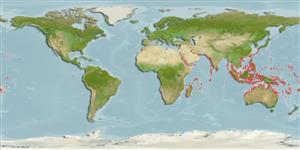>
Blenniiformes (Blennies) >
Blenniidae (Combtooth blennies) > Blenniinae
Etymology: Petroscirtes: Latin, petra, -ae = stone + Greek, skirteo = to jump.
More on author: Rüppell.
Environment: milieu / climate zone / depth range / distribution range
Ecologie
marien rifbewoner; diepte 0 - 8 m (Ref. 86942). Tropical; 30°N - 30°S
Indo-Pacific: Red Sea and East Africa to the Phoenix, Samoan and Tongan islands, north to Ryukyu Islands, south to Australia and New Caledonia.
Grootte / Gewicht / Leeftijd
Maturity: Lm ? range ? - ? cm
Max length : 8.5 cm TL mannelijk / geslacht onbekend; (Ref. 48636)
Korte beschrijving
Determinatiesleutels | Morfologie | Morfometrie
Dorsale stekels (totaal) : 10 - 11; Dorsale zachte stralen (totaal) : 14 - 17; Anale stekels: 2; Anale zachte stralen: 14. Head and body speckled and mottled; 5-6 indistinct, dark blotches or bands on body usually with dark-edged ocelli above (Ref. 4404). First three rays of dorsal fin are elevated.
Adults are found solitary or in small groups (Ref. 90102) in shallow protected lagoons and reef flats with algal and seagrass clumps. Juveniles often in floating Sargassum weeds and maybe dispersed over great distances (Ref. 48636). They swim with the tail oriented vertically. Oviparous. Eggs are demersal and adhesive (Ref. 205), and are attached to the substrate via a filamentous, adhesive pad or pedestal (Ref. 94114). Empty mollusk shells are used for nesting. Larvae are planktonic, often found in shallow, coastal waters (Ref. 94114). Captured at the surface using a hand net (Ref. 26165).
Levenscyclus en paargedrag
Maturiteit | Voortplanting | Paaien | Eieren | Fecunditeit | Larven
Oviparous, distinct pairing (Ref. 205).
Myers, R.F., 1991. Micronesian reef fishes. Second Ed. Coral Graphics, Barrigada, Guam. 298 p. (Ref. 1602)
Status op de Rode Lijst van het IUCN (Ref. 130435: Version 2024-1)
Gevaar voor de mens
Harmless
Gebruik door de mens
Visserij: commercieel; Aquarium: Commercieel
Tools
Speciale rapporten
Download XML
Internetbronnen
Estimates based on models
Preferred temperature (Ref.
123201): 25 - 29.3, mean 28.4 °C (based on 3369 cells).
Fylogenetische diversiteitsindex (Ref.
82804): PD
50 = 0.5005 [Uniqueness, from 0.5 = low to 2.0 = high].
Bayesian length-weight: a=0.00575 (0.00253 - 0.01308), b=3.06 (2.86 - 3.26), in cm total length, based on LWR estimates for this (Sub)family-body shape (Ref.
93245).
Trofisch niveau (Ref.
69278): 2.0 ±0.0 se; based on diet studies.
Weerstandsvermogen (Ref.
120179): Hoog, minimale populatieverdubbelingstijd minder dan 15 maanden (Preliminary K or Fecundity.).
Fishing Vulnerability (Ref.
59153): Low vulnerability (10 of 100).
Nutrients (Ref.
124155): Calcium = 186 [90, 329] mg/100g; Iron = 0.926 [0.515, 1.667] mg/100g; Protein = 17.9 [16.6, 19.0] %; Omega3 = 0.0796 [, ] g/100g; Selenium = 21.2 [9.9, 49.2] μg/100g; VitaminA = 114 [28, 469] μg/100g; Zinc = 2.83 [1.81, 4.20] mg/100g (wet weight);
